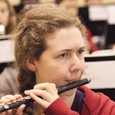.jpg)
Each fall band, orchestra, and flute choir directors look for flutists to play piccolo in their ensembles. Students also may ask their private teachers about trying the instrument. With instruction any flutist should be able to play piccolo comfortably, but some flutists are better suited to playing piccolo on a regular basis than others.
The Role of the Piccolo
The piccolo has a unique and important role to play in any band or orchestra. Like other auxiliary instruments (English horn, contrabassoon, Eb and bass clarinets), the piccolo operates as an extension of the range of its parent instrument, and as a hyper-distillation of that instrument’s particular color. In the best cases, this miniature-flute is just that – a tiny instrument with an exceptionally agile, vocal quality that brings the flute’s expressivity, virtuosity, and coloristic variety to the extreme upper ranges of the ensemble. However, the dark side of this little flute is well-known. More often than not, listeners experience the piccolo as a weaponized woodwind, violently shrieking out the top line in ensemble passages, and the poor piccolo player is held hostage to the treacherous intonation of both the instrument and the harmonic series, coldly multiplying upwards into oblivion.
Piccolo Personality
It takes a particular kind of person to embrace the challenges, potential pitfalls, and great rewards of playing an instrument like the piccolo. Although some methods of teaching start very young flute students on the piccolo (especially in South America), most flutists in the United States begin playing the flute in middle school and are not exposed to the piccolo until they have been playing for a few years.
A good candidate for piccolo is a student who has developed strong fundamentals on the flute, particularly with tonal control, technique, and intonation. A flutist with a clean, efficient sound (even one on the smaller side) does well with the piccolo because such a sound usually generates from a controlled, firm embouchure. Embouchure control is of paramount importance in managing the airstream and allowing a flute player to transition to piccolo without just blowing harder to get the notes out.
A good candidate for the piccolo chair embraces the soloistic nature of the instrument, but also has a cooperative nature. The piccolo is part of the flute section, and often doubles flute material. It is also the only instrument in the ensemble with the ability to play in the very top octave. It is a great thrill to be at the center of the action, riding the high moments of the band or orchestra, and this can be an excellent selling point for students considering piccolo. However, there are also plenty of moments when the piccolo player should compromise and blend to create beautiful colors that are more than the sum of their parts. An ideal piccolo player is someone who is both very independent and a good-natured collaborator.
Airstream and Embouchure
Piccolo playing requires a great deal of support, but actually uses less air than the flute. The airstream is narrower, and the speed required to access the high register comes from channeling that air through the controlled, small aperture of the lips. Students learn to form a flute embouchure by imagining they are spitting a piece of rice or tissue off of the center of their lips (say “puh”). A good piccolo embouchure also relies on allowing the airstream to exit from a tiny, focused hole between the lips, and then sustaining that level of tone in the muscles surrounding the aperture.
Firmness in the embouchure differs greatly from tension, and a flutist with an extremely tight embouchure may have trouble with buzzing on piccolo. Buzzing occurs when a narrow, fast airstream is forced through a too tight embouchure, and the lips cannot contain the airstream so they vibrate together. This phenomenon occurs mostly in the highest ranges of the instrument and can be eliminated by the counterintuitive solution of relaxing and blowing less. An excellent way to practice relaxing into the high register is to play slow, even, five-note scales (tonic to dominant) from the top of the staff, moving up by half-step, making sure to keep the airstream free but supported, and not shying away from the high notes.
Transposition
Since the piccolo sounds an octave higher than written, it is useful to encourage students to practice piccolo parts on flute in the octave that they sound whenever possible. For example, if there is a piccolo solo in the top range of the staff that can be played an octave higher on the flute, playing the excerpt on flute first can help relate the aural result, as well as the necessary support and em-bouchure control, to the same passage on the piccolo.
This is particularly helpful in the sometimes overlooked middle register of the piccolo, which can be unstable in comparison to the same written notes on the flute. Imagining that you are playing a high E on the flute, while playing the middle E on the piccolo can help center the tone and provide a reference for the necessary support in that register.
Technique, Vibrato, and Intonation
Besides embouchure control, potential piccolo players should have control of their technique and intonation. Being half the size of the flute, everything on the piccolo is miniaturized. Technique should be closer, cleaner, and more economical. A student’s natural hand position should be comfortable enough on the flute to allow them to bring the whole apparatus closer to their face without increasing tension in the arms and left hand (for some smaller-bodied flutists, the hand position on piccolo can even be more comfortable than the flute, but this does not preclude larger students from comfortably making the transition).
The vibrato too should be smaller. Flutists with a light, internal, spinning vibrato will adapt much more easily to the piccolo than those with a thicker, slower, fuller vibrato. Again, students should relate the piccolo vibrato to the appropriate vibrato in the same register on the flute, and consider that vibrato exists within the sound. Since the airstream and tonal resonance on the piccolo is smaller than on the flute, a much narrower vibrato should be used in order to fit inside the sound.
Perhaps most crucially, a flutist who aspires to the piccolo chair should have a good grasp of intonation on the flute, and the ability to make subtle changes to correct the pitch. The piccolo is often out of tune as a function of its place atop the whole harmonic series; the frequency of A=440 is actually 880 or 1760 once you get to the octave of the piccolo, so any discrepancies in intonation are quickly magnified. A piccolo player often makes small adjustments to correct the pitch. It is highly advisable that piccolo players make a pitch tendency chart for their instrument with a tuner. A student should note which pitches have different tendencies from the flute. In tricky intonation tangles, it can be extremely helpful to have a concept of what the problem might be and to remember how much adjustment that note typically requires. A flutist who already has a natural ear for intonation will be able to make these corrections subtly and without over-analyzing the situation.
Metal, Resin, or Wood?
The type of piccolo someone is first exposed to will have a great effect on whether they enjoy playing the instrument and want to go further with it. There are two basic types of piccolos: cylindrical bore metal piccolos and conical bore wooden piccolos. Metal piccolos are great for beginners and for use in marching band because they are the least expensive ($200-$1000), most indestructible, and look most like the flute. However, they are also the shrillest and have inconsistent intonation. Conical bore wooden piccolos (made of Grenadilla or Cocus wood, like oboes and clarinets) are the standard in the professional world because they have a more consistent, flute-like tone throughout the range of the instrument, blend better with the other winds, and usually have better intonation. However, they are much more difficult to care for and are much more expensive ($2000-$8000).
A wooden piccolo should never be taken outside or used for marching band because it is prone to cracking. An excellent compromise is a plastic or wood composite model. These are durable, have a pleasant sound, are less expensive ($800-$1200), and provide a good bridge to a better instrument later on.
When I won my first job on piccolo, David Carroll, of the New York Philharmonic, told me he thought any great wind section was defined by its piccolo player. I found this very surprising, coming from a bassoonist, who was married to a world-famous principal flutist (my teacher, Jeanne Baxtresser). His point was that the piccolo is almost always audible, so a piccolo player adds something wonderful to the complexity and completeness of an ensemble’s sound. While every instrument adds its own crucial voice, the right person on piccolo will lend any band or orchestra a new polish and, quite literally, take the ensemble to a new high.






